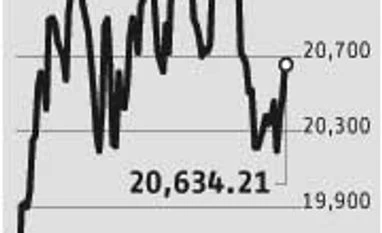The third-quarter earnings season has ended on a positive note and no downgrades are imminent. The net profit of 30 Sensex companies has increased 24 per cent compared to last year. Sequentially, too, these companies have grown their earnings by 14 per cent. Even if one takes adjusted profits of the 30 Sensex companies (adjusted for one-time gains), their net profit has risen 23 per cent year-on-year. A large part of the good earnings cheer has been driven by export sectors such as pharmaceuticals and information technology (IT). This pattern is similar to the second quarter, during which earnings had gotten a boost from the rupee’s fall. So, does this mean the quality of earnings is actually improving? Clearly not, even though margins have expanded during the quarter.
With the rupee remaining stable, the sustainability of earnings growth is not a given. The second big trend this quarter has shown is the weakness in volume growth. Most consumer companies — with the exception of some — have shown a collapse in volumes. This is not yet reflected in the valuations of consumer companies. Even though operating profit of Sensex companies has improved sequentially and annually, there are different factors that have led to this improvement. The improvement is not due to a secular pick-up in growth. Kotak Institutional Equities believes the sequential improvement in operating margins of auto companies is due to decrease in raw material costs and or lower operating costs. On the other hand, year-on-year decline in margins of cement companies is because of lower prices and weak volumes. The earnings season may have ended on a good note, but the macro-economic signs are still ominous as bank credit has slowed sharply, demand is steadily declining, and volumes are falling across sectors. The sustainability of earnings growth depends on economic growth.
With the rupee remaining stable, the sustainability of earnings growth is not a given. The second big trend this quarter has shown is the weakness in volume growth. Most consumer companies — with the exception of some — have shown a collapse in volumes. This is not yet reflected in the valuations of consumer companies. Even though operating profit of Sensex companies has improved sequentially and annually, there are different factors that have led to this improvement. The improvement is not due to a secular pick-up in growth. Kotak Institutional Equities believes the sequential improvement in operating margins of auto companies is due to decrease in raw material costs and or lower operating costs. On the other hand, year-on-year decline in margins of cement companies is because of lower prices and weak volumes. The earnings season may have ended on a good note, but the macro-economic signs are still ominous as bank credit has slowed sharply, demand is steadily declining, and volumes are falling across sectors. The sustainability of earnings growth depends on economic growth.
)